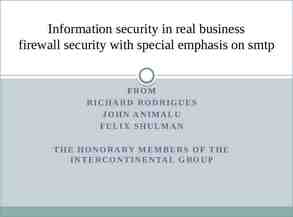Charles Hakes Fort Lewis College 1
44 Slides4.76 MB
Charles Hakes Fort Lewis College 1
Charles Hakes Fort Lewis College 2
Chapter 2 Light and Matter Charles Hakes Fort Lewis College 3
Outline Logistics Review Light and Matter Waves Charles Hakes Fort Lewis College 4
Logistics Test 1 will be Friday next week. 3 minute “paragraphs” Re-use pages add dates Avoid “about” say something specific. iClicker registration (email?) Tutor (!?) Charles Hakes Fort Lewis College 5
Your Folder Full name on the tab BIG name on the front Major on upper right Class on lower left A comment about yourself on the lower right Inside - your most recent, or current, math class (subject, course number, and year taken.) Include your daily three minute papers! You can reuse pages, just add the date. Say something specific. Charles Hakes Fort Lewis College 6
Review What was the most important thing you learned? The smaller the parallax shift of an object the further away the object is. There are 2 radians in a circle. Charles Hakes Fort Lewis College 7
Radians Not just an extra button on your calculator 2 radians in a circle Conversion formula 2 rad 360 Conversion practice page on-line! Charles Hakes Fort Lewis College 8
Small Angle Approximation Angle must be in radians Angle must be small (opposite adjacent) Then: sin( ) tan( ) Charles Hakes Fort Lewis College 9
Small Angle Approximation For small angles in radians: angle baseline/distance Charles Hakes Fort Lewis College 10
Small Angle Approximation For small angles in radians: angle baseline/distance or distance baseline/angle or baseline angle*distance Charles Hakes Fort Lewis College 11
If your baseline is 25cm, and you observe a parallax shift of 0.01 rad. The distance to the object is: 1: 2.5cm 2: 2500cm 3: 25000cm Charles Hakes Fort Lewis College 12
More Precisely P-2b Measuring Distances with Geometry Charles Hakes Fort Lewis College 13
Small Angle Approximation If you know the size of an object, you can determine it’s distance using the same triangle formulas distance baseline/angle This time the “baseline” is the known diameter of the object and the angle is the observed apparent “size” of the object. Charles Hakes Fort Lewis College 14
You see your friend in the distance and measure that they “subtend” 1 degree. How many radians is that? A) 57 B) 1.6 C) .034 D) .017 E) .012 Charles Hakes Fort Lewis College 15
You know your friend is 1.6m tall, and that they “subtend” 0.017 radians. How far away are they? A) 94m B) 0.27m C) 163m D) 57m E) 106m Charles Hakes Fort Lewis College 16
Where does the full moon rise in Durango on June 21? A) North of east (by more than 5 ) B) Within 5.2 of due east C) South of east (by more than 5 ) D) Not enough information
Where does the full moon rise in Durango on June 21? A) North of east (by more than 5 ) B) Within 5.2 of due east C) South of east (by more than 5 ) D) Not enough information Charles Hakes Fort Lewis College
Chapter 2 The Ring Nebula Charles Hakes Fort Lewis College 19
Chapter 2 The Ring Nebula Charles Hakes Fort Lewis College 20
Figure 2.1 Andromeda Galaxy Charles Hakes Fort Lewis College 21
Radiation Astronomical objects are VERY far away. How do we learn about them? Charles Hakes Fort Lewis College 22
Radiation Astronomical objects are VERY far away. How do we learn about them? Answer - light electromagnetic radiation rays waves Charles Hakes Fort Lewis College 23
Figure 2.8 Electromagnetic Spectrum Charles Hakes Fort Lewis College 24
Figure 2.2 Water Wave Charles Hakes Fort Lewis College 25
Waves Waves - a disturbance making a distinctive, repeating pattern. The disturbance is what moves - not the medium. Charles Hakes Fort Lewis College 26
Types of Waves Transverse waves in solids example earthquakes Charles Hakes Fort Lewis College 27
Types of Waves Transverse waves in solids example earthquakes Compressional waves in solids or liquids or gasses example sound Charles Hakes Fort Lewis College 28
Types of Waves Transverse waves Compressional waves in solids example earthquakes in solids or liquids or gasses example sound Electromagnetic waves in nothing (vacuum) Charles Hakes Fort Lewis College 29
Wave Properties Period Frequency how long one cycle is units are seconds 1/period units are Hertz (per second, 1/sec, or sec-1) wavelength wave speed (velocity) amplitude Charles Hakes Fort Lewis College 30
Figure 2.3 Wave Properties Charles Hakes Fort Lewis College 31
Wave Properties Wavelength x frequency velocity Charles Hakes Fort Lewis College 32
Wave Properties Wavelength x frequency velocity c Charles Hakes Fort Lewis College 33
Which wave is fastest when traveling through space? A) Light from a light bulb B) Green laser C) FM radio waves D) X-rays from a dentist office E) They are all the same speed Charles Hakes Fort Lewis College 34
The Speed of Light 299,792.458 km/sec ( 3.00x108 m/s) It’s not just a good idea. It’s the law! Charles Hakes Fort Lewis College 35
History of The Speed of Light Date 1676 1726 1849 1862 1879 1907 Author Olaus Roemer James Bradley Armand Fizeau Leon Foucault Albert Michelson Rosa, Dorsay 1926 1947 1958 1973 1983 Abert Michelson Essen, Gorden-Smith K. D. Froome Evanson et al Adopted Value Charles Hakes Fort Lewis College Method Jupiter's satellites Stellar Aberration Toothed Wheel Rotating Mirror Rotating Mirror Electromagnetic constants Rotating Mirror Cavity Resonator Radio Interferometer lasers 36 Result (km/s) 214,000 301,000 315,000 298,000 299,910 299,788 Error 299,796 299,792 299,792.5 299,792.4574 299,792.458 -4 -3 -0.1 -0.001 -500 -50 -30
Figure 2.4 Charged Particles Charles Hakes Fort Lewis College 37
Figure 2.5 Magnetism Charles Hakes Fort Lewis College 38
Figure 2.6 Electromagnetic Wave Charles Hakes Fort Lewis College 39
Figure 2.7 Visible Spectrum Charles Hakes Fort Lewis College 40
Figure 2.8 Electromagnetic Spectrum Charles Hakes Fort Lewis College 41
Which list is in the correct order of electromagnetic radiation wavelength, going from shortest to longest? A) infrared, ultraviolet, gamma, radio B) gamma, x-ray, ultraviolet, visible C) radio, infrared, visible, ultraviolet D) radio, x-ray, ultraviolet, visible E) red, violet, blue, green Charles Hakes Fort Lewis College 42
Which is correct A) B) C) D) Charles Hakes Fort Lewis College wavelength / velocity frequency wavelength / velocity period wavelength * frequency period wavelength * velocity frequency 43
Three Minute Paper Write 1-3 sentences. What was the most important thing you learned today? What questions do you still have about today’s topics? Charles Hakes Fort Lewis College 44

















































